A blog to explore creative media in the hopes of furthering my own productions.
Friday, 30 December 2011
Bordwell's Discussion of Experimental Film
Wednesday, 28 December 2011
Girl with the Dragon Tattoo

Tuesday, 20 December 2011
Hello Again
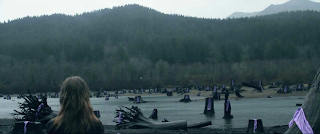
Friday, 16 December 2011
Feedback from the presentation
Tuesday, 13 December 2011
Final Assembly
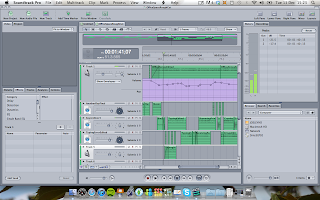 Here we've put together the tracks as they are in the final assembly, there are some changes to volume that can be seen here. The use of layering to put our piece together was invaluable, it helped to create the crescendo of activity that we had wanted to put in and also meant that the sounds we needed to create an office didn't all have to be merged into one recording, giving us more room to change aspects of the office scape, for example, having a phone come in a second sooner than we'd planned.
Here we've put together the tracks as they are in the final assembly, there are some changes to volume that can be seen here. The use of layering to put our piece together was invaluable, it helped to create the crescendo of activity that we had wanted to put in and also meant that the sounds we needed to create an office didn't all have to be merged into one recording, giving us more room to change aspects of the office scape, for example, having a phone come in a second sooner than we'd planned.
Volume Adjustment
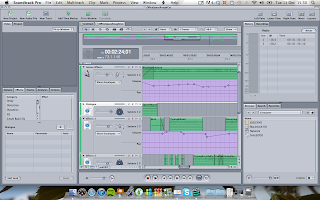 Here we were adjusting the volume of the individual clips after our tutorial proved the levels became too loud with the layering of multiple clips. We've adjusted it manually so that the volume will rise and fall as it needs to in order to keep this sequence a busy build up but without being too loud. Another great use of manual volume adjustment is to accentuate one sound over another - which we did want to do with some clips, such as the crisp packet to give the sense of annoyance that comes with just one small action when you're working in an office, even as a cleaner but of course for different reasons.
Here we were adjusting the volume of the individual clips after our tutorial proved the levels became too loud with the layering of multiple clips. We've adjusted it manually so that the volume will rise and fall as it needs to in order to keep this sequence a busy build up but without being too loud. Another great use of manual volume adjustment is to accentuate one sound over another - which we did want to do with some clips, such as the crisp packet to give the sense of annoyance that comes with just one small action when you're working in an office, even as a cleaner but of course for different reasons.
Panning
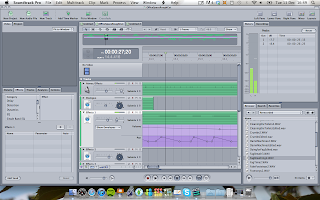 These screen grabs are an example of the panning that we added to our piece, we included this on not only the clips where she would be walking past the noise and so it would go from her left to right ear, but also on the noises that she was making, such as sweeping from left to center and then right to center to give a sense of movement and action around the cleaner and bring her presence more into focus.
These screen grabs are an example of the panning that we added to our piece, we included this on not only the clips where she would be walking past the noise and so it would go from her left to right ear, but also on the noises that she was making, such as sweeping from left to center and then right to center to give a sense of movement and action around the cleaner and bring her presence more into focus.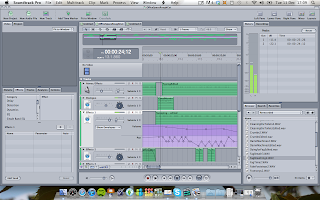
Typing Error
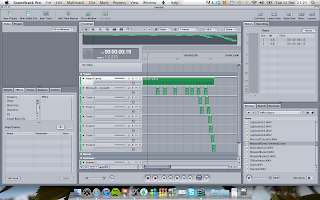 The above is a screen shot of making the typing error sound effect. We used layers to create the sound effect and just carefully lined up the error noise with each tap of the key. This took a little longer than we first suspected because of making sure the gaps were all consistent and that we had covered every keyboard tap. Once we were happy, we exported this so that it made it into one sound and is therefore easier to edit into place on the final assembly.
The above is a screen shot of making the typing error sound effect. We used layers to create the sound effect and just carefully lined up the error noise with each tap of the key. This took a little longer than we first suspected because of making sure the gaps were all consistent and that we had covered every keyboard tap. Once we were happy, we exported this so that it made it into one sound and is therefore easier to edit into place on the final assembly.
Monday, 12 December 2011
Editing
Some screen grabs of editing will follow soon!
Thursday, 8 December 2011
Feedback from our Second Tutorial
Something we all agreed on as a definite change was the voice of the cleaner. We were already unhappy with the recordings but Esther's input cemented the idea to rerecord in our plans. The voice was too much for the piece and I agree that maybe by rerecording we can get a lot more out of the overall work. For one thing, Hannah and I have decided to record the voice in a more monotonous tone to indicate an internal voice rather than the more emotive dialogue we'd gotten to begin with.
Esther suggested we should separate the cleaner and the workers more, that they were too integrated at present. I think that with more panning and sorting out our levels, once we've reintroduced the new voice recordings that this will be a lot clearer between where she is in relation to them. The panning to create the sense of her movement through the space should also help a lot in creating those boundaries.
Wednesday, 7 December 2011
Flying In Tokyo
Sunday, 4 December 2011
Air Freshener
That happened with a recording of air freshener being sprayed, it's so difficult to tell what it is, we probably won't get to use it in our final piece but it's an interesting sound to add to my sound library.
Friday, 2 December 2011
Islands
This song builds from an instrumental, to one voice, to the other and finally to two joint voices. I find that, even though it's quite upbeat, the nature of the voices make the track quite relaxing. The melody of the joint voices is so aurally pleasing that I find myself listening to this track repeatedly, as if I can't get it out of my head.
Wednesday, 30 November 2011
Gymnopédie No 1
Monday, 28 November 2011
Typing Error
Sunday, 27 November 2011
Timeline
Saturday, 26 November 2011
We need to talk about Kevin
One thing that struck me and resonated even as I was sat at home that evening, was the sound design. One particular repeated effect of sprinklers that was present in parts of the film then linked in with the ending so that it foretold the events that were to be revealed to the audience. This is even more interesting because the events that are revealed at the end of the film actually happen to the character before we even join her at the beginning, therefore, the sprinkler sounds can actually be attributed to her own beliefs and links of those events to the ones we discover at the end, as if she has actually included them in her recollections of her past and actually made a connection in her mind. This signifies that she is searching for a cause of the big event and those are the ones she has picked out as points in time that could possibly have contributed in her opinion.
There was also an interesting sound link where the sounds from the next shot are woven in with the actions of the current shot so that you know that action should not create those sounds but because it then links with the next scene it's preempting what's to come and almost makes sense to be used with that object.
The style of the film really allows for a psychological exploration and journey through a characters mind and justifications for just one event. The reveal at the end of the film is justified because it allows you to feel the psychology of the character, trying to make connections, trying to make sense of why this has happened and not fully understanding or being able to accept what has actually happened until the very end of the film when you discover almost as she does.
I would really like to include some of these sound techniques in future projects, as I feel linked with an image, it can create connections within the text and give room for extra thought, even after the film has ended.
Thursday, 24 November 2011
Feedback from our Tutorial
Also, this aspect changes some of the sound effects the piece will incorporate, such as the use of hoovering, sweeping and spraying. Not only do the sound effects become more varied but the environment can be changed now due to not having the restrictions of an office worker - the cleaner will visit many more places in a day than a worker and so this can work for us in terms of different atmospheres and scenarios.
Wednesday, 23 November 2011
Outline for Idea
Outline for Idea - “Office Space”
Our idea is to show our spaces progression through time, from starting midmorning in an office setting through to the evening when the office becomes a cleaning ground and finally the buzz of machines left on overnight, with a light switch being turned off to signify the end of the track.
So far, we have thought of varying stages through the day where an office’s sounds may fluctuate such as, tea break, smoking breaks, lunchtimes and then when the day would be busier such as peak call times just after lunch. We also think the atmos track can be made of two layers, the sounds of the machines - typing, whirring and the sounds of workers talking - on phones and to each other.
To introduce the piece, there will be a solitary phone ringing and then we want to use a female voice that announces “Good morning, you’re through to (name) at (company name)” then fade up the atmos around her. She will be the main voice throughout the piece to situate the viewer at points in time, such as cigarette breaks and asking if anyone wants tea followed by a kettle boiling. Although she will be the main voice, we would like to include snatches of conversations, i.e two office workers talking about another worker etc.
We want to try using the hydrophone to capture some interesting sounds of “tea” being poured into a cup. Also, following our workshop on Monday, we want to use the cover to try capturing ‘below the surface’ noises such as machines whirring.
Other noises we will include will be close up sounds of typing, photocopying and phones ringing. Also, we could have the sound of refilling paper in a printer, accompanied by beeping noises it makes due to a malfunction which introduces room for our main voice to say “Stupid thing” and start rattling the drawers/banging on machine. We could also use fax noises, like the sounds of incoming fax.
We’d like to introduce the boredom of the space too, by using sounds of a clock ticking and then a pen tapping on paper in the anticipation of lunch which would be made clear by the voice declaring lunch time after the ticking of the clock. At which point we were thinking to fade out the voices to indicate them leaving for lunch and then just having a silent point in the piece. This would signify the intensity of the office environment and then the break from the stresses of the busy day that occurs there, we want this to make the audience feel the relief of the room, as if it gets a break too.
Could also have a window opening and the noises from outside coming through, such as traffic noises, which later could be closed when a worker complains of cold? Giving a sense of temperature to the piece.
During a break where some of the office leave - such as cigarette break, the quieter environment of the few office workers left can be punctuated with close up sounds of a crisp packet being opened and then the crunching of eating them.
The end of the day will be signified by goodbye’s and then the whirring in between cleaners arriving, then spraying sounds of cleaning solution being spray, then hoovering and finally emptying bins before the ending light switch. Might include the finality of relief from a worker signified by a lighter being used and then a deep breath inhaling and exhaling.
Schedule
Schedule
Week 17 - Planning
23/11/11
Meeting to discuss initial ideas.
Book equipment following meeting
Draw up mindmaps and schedule.
24/11/11 - 28/11/11
Source office specific sound tracks - i.e films that incorporate office sound sequences, sound tracks about offices etc.
Review at least 1 sequence
Week 18 - recording sounds
28/11/11
- Get equipment out
29/11/11 - 01/12/11
Record and log sounds
Week 19 - editing track - rough edit/final edit
5/12/11 - 7/12/11
- Rough editing
Week 20 - Contingency time and Presentation
12/12/11 - 14/12/11
Contingency editing time
Plan presentation
15/12/11
Present
Techniques
Monday, 21 November 2011
Cafe Noise
Sunday, 20 November 2011
Jarman's Garden - Produced by Sherre Delys
"Ol-olool-O"
Friday, 18 November 2011
Sense of Space
The new assignment is to convey a sense of space through a 3 minute track. When I read the brief, I couldn’t wait to get started! Far from finding the task daunting, despite having little experience with creating sound tracks and recording sounds, I find myself quite enthusiastic and have a few initial ideas in mind already. To further this, I plan to spend some time this weekend sitting in some of these spaces to try to get a sense of the place and what sounds there are, which ambient noises and atmos tracks I could use and whether there are any intermittent sounds that could be used to effect.
I quite like the idea of exploring the space in a cafe using sounds such as clinking of cups, the coffee machine, the chattering buzz of talk as an atmos track and the occasional sound of the till being opened.
Another interesting space could be a central area or busy road but graduating from early morning where there are fewer sounds to a crescendo of activity - namely the workers commuting to work. This could involve an increasing noise of trams, different car engines, a car horn, hearing the footsteps of hurrying workers as they rush to get to work juxtaposed with the beginning which could be the cleaning carts that go around the city, the rustle of leaves on the ground, a tin can being blown across the street.
Finally, I thought of an office space. The clacking of keyboards, the drone of workers answering phones, a ringing noise, the sound of notes being written and noises of photocopying. Again this could build up from an early morning scenario with the sounds of a hoover to indicate the cleaners, a blind being drawn and then the first workers arriving - the click of the kettle from tea being made. The whirring of the machines and fans could also be used throughout the piece to indicate periods of still.
Tuesday, 8 November 2011
Final Edit
Thursday, 3 November 2011
Feedback
Tuesday, 1 November 2011
Editing
Friday, 28 October 2011
Edale Shoot
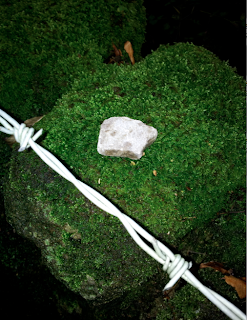
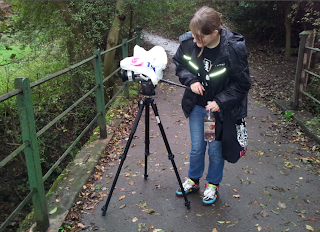
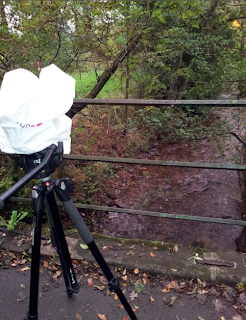
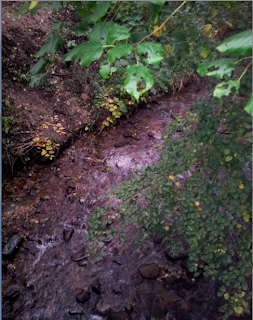
Thursday, 27 October 2011
Shot List for Edale so far
I've created a shot list for the Edale shoot but I don't think there's enough on there to get us up to three minutes. This is the first comprehensive shot list I've created, as before I've always just done one as an addition to storyboarding, but this time I've done it in the hopes of increasing my ideas for the final storyboard. I used the first storyboard I made as a starting point for this shot list with a few extra ideas added and am now in the process of drawing up a final storyboard which I'll add on here hopefully Wednesday. I'm glad I used this method when planning this short as it gives me a sense of what I want to include and where in the sequencing I want things to go. I've never used scene and act before to order shots and this is helpful in this document for creating segments of action.
SHOT LIST
| SHOT NUMBER | SCENE | ACT | LOCATION | TYPE AND DESCRIPTION OF SHOT |
| 1 | 1 | 1 | Edale | Estab. l/s, pan across landscape. |
| 2 | 1 | 1 | Edale | C/u gravel path - pebble not in focus |
| 3 | 1 | 1 | Edale | c/u gravel path - rack focus to pebble |
| 4 | 1 | 1 | Edale | M/s of path as walker walks through |
| 5 | 1 | 1 | Edale | c/u Pebble rolling away |
| 6 | 1 | 2 | Edale | POV shot - sky - boot comes into view toward screen |
| 7 | 1 | 2 | Edale | c/u of walkers shoes as walks along |
| 8 | 2 | 1 | Edale | POV shot - new surroundings |
| 9 | 2 | 1 | Edale | c/u hand coming towards pebble from POV |
| 10 | 2 | 1 | Edale | mid-c/u of hand throwing pebble |
| 11 | 3 | 1 | Edale | l/s of new surroundings |
| 12 | 3 | 1 | Edale | midshot of pebble’s landing |
| 13 | 3 | 1 | Edale | c/u of shoe where pebble landed |
| 14 | 3 | 2 | Edale | pov shot - boot towards screen, away from then toward screen as if walking |
| 15 | 3 | 2 | Edale | Midshot of style, legs walk in and climb over |
| 16 | 3 | 2 | Edale | c/U pebble falling off shoe |
| 17 | 3 | 3 | Edale | midshot pebble rolling down hill |
| 18 | 3 | 3 | Edale | c/u of pebble coming to rest |
| 19 | 4 | 1 | Edale | mid shot of surroundings |
| 20 | 4 | 1 | Edale | pov hand coming towards pebble |
| 21 | 4 | 2 | Edale | mid-c/u of hand palm up with pebble on palm |
| 22 | 4 | 2 | Edale | ECU of pebble, fingers close round it. |
Shot List for Edale so far
I've created a shot list for the Edale shoot but I don't think there's enough on there to get us up to three minutes. This is the first comprehensive shot list I've created, as before I've always just done one as an addition to storyboarding, but this time I've done it in the hopes of increasing my ideas for the final storyboard. I used the first storyboard I made as a starting point for this shot list with a few extra ideas added and am now in the process of drawing up a final storyboard which I'll add on here hopefully Wednesday. I'm glad I used this method when planning this short as it gives me a sense of what I want to include and where in the sequencing I want things to go. I've never used scene and act before to order shots and this is helpful in this document for creating
SHOT LIST
| SHOT NUMBER | SCENE | ACT | LOCATION | TYPE AND DESCRIPTION OF SHOT |
| 1 | 1 | 1 | Edale | Estab. l/s, pan across landscape. |
| 2 | 1 | 1 | Edale | C/u gravel path - pebble not in focus |
| 3 | 1 | 1 | Edale | c/u gravel path - rack focus to pebble |
| 4 | 1 | 1 | Edale | M/s of path as walker walks through |
| 5 | 1 | 1 | Edale | c/u Pebble rolling away |
| 6 | 1 | 2 | Edale | POV shot - sky - boot comes into view toward screen |
| 7 | 1 | 2 | Edale | c/u of walkers shoes as walks along |
| 8 | 2 | 1 | Edale | POV shot - new surroundings |
| 9 | 2 | 1 | Edale | c/u hand coming towards pebble from POV |
| 10 | 2 | 1 | Edale | mid-c/u of hand throwing pebble |
| 11 | 3 | 1 | Edale | l/s of new surroundings |
| 12 | 3 | 1 | Edale | midshot of pebble’s landing |
| 13 | 3 | 1 | Edale | c/u of shoe where pebble landed |
| 14 | 3 | 2 | Edale | pov shot - boot towards screen, away from then toward screen as if walking |
| 15 | 3 | 2 | Edale | Midshot of style, legs walk in and climb over |
| 16 | 3 | 2 | Edale | c/U pebble falling off shoe |
| 17 | 3 | 3 | Edale | midshot pebble rolling down hill |
| 18 | 3 | 3 | Edale | c/u of pebble coming to rest |
| 19 | 4 | 1 | Edale | mid shot of surroundings |
| 20 | 4 | 1 | Edale | pov hand coming towards pebble |
| 21 | 4 | 2 | Edale | mid-c/u of hand palm up with pebble on palm |
| 22 | 4 | 2 | Edale | ECU of pebble, fingers close round it. |
